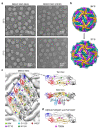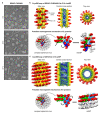Morphological Diversity and Dynamics of Dengue Virus Affecting Antigenicity
- PMID: 34452312
- PMCID: PMC8402850
- DOI: 10.3390/v13081446
Morphological Diversity and Dynamics of Dengue Virus Affecting Antigenicity
Abstract
The four serotypes of the mature dengue virus can display different morphologies, including the compact spherical, the bumpy spherical and the non-spherical clubshape morphologies. In addition, the maturation process of dengue virus is inefficient and therefore some partially immature dengue virus particles have been observed and they are infectious. All these viral particles have different antigenicity profiles and thus may affect the type of the elicited antibodies during an immune response. Understanding the molecular determinants and environmental conditions (e.g., temperature) in inducing morphological changes in the virus and how potent antibodies interact with these particles is important for designing effective therapeutics or vaccines. Several techniques, including cryoEM, site-directed mutagenesis, hydrogen-deuterium exchange mass spectrometry, time-resolve fluorescence resonance energy transfer, and molecular dynamic simulation, have been performed to investigate the structural changes. This review describes all known morphological variants of DENV discovered thus far, their surface protein dynamics and the key residues or interactions that play important roles in the structural changes.
Keywords: antibody complex; dengue; flavivirus; morphological changes.
Conflict of interest statement
The authors declare no conflict of interest.
Figures



References
-
- Capeding M.R., Tran N.H., Hadinegoro S.R., Ismail H.I., Chotpitayasunondh T., Chua M.N., Luong C.Q., Rusmil K., Wirawan D.N., Nallusamy R., et al. Clinical efficacy and safety of a novel tetravalent dengue vaccine in healthy children in Asia: A phase 3, randomised, observer-masked, placebo-controlled trial. Lancet. 2014;384:1358–1365. doi: 10.1016/S0140-6736(14)61060-6. - DOI - PubMed
Publication types
MeSH terms
Substances
LinkOut - more resources
Full Text Sources
Medical

